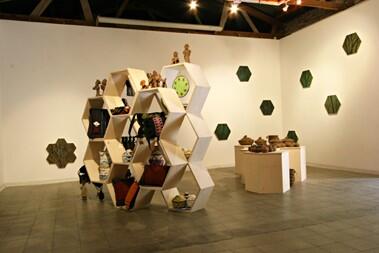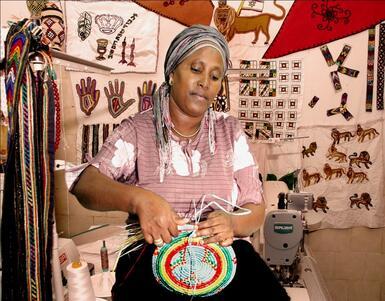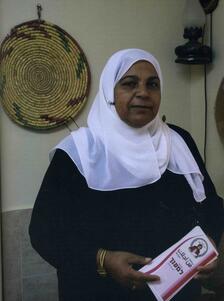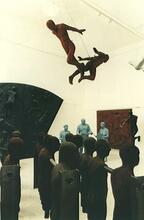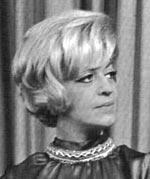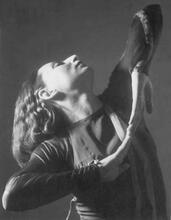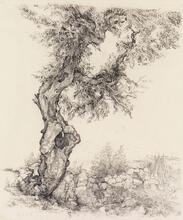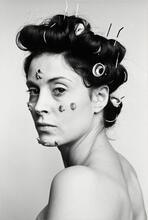Shula Keshet
Mizrahi feminist activist, artist, and curator Shula Keshet was born in Israel to a family from Mash’had, Iran. She is a leading figure in several social movements striving for justice for underprivileged men and women in Israel. Keshet was a founding member of the Mizrahi feminist group “Achoti – For Women in Israel” and has served as editor-in-chief of Achoti Press. As a Mizrahi feminist artist and curator, she has initiated several exhibitions. Her exhibitions “Black Labor” and “Women Creating Change” embody the principles behind the vision and activism of Mizrahi feminist politics. “Black Labor” was based on a series of meetings, art events, and mutual-learning sessions for groups of Mizrahi, Ethiopian, Palestinian, and Bedouin women artists. “Women Creating Change” contained the portraits of 38 feminist activists working in the community and academia.
Shula Keshet was born in Israel on August 2, 1959. Her family is from Mash'had, Iran. Keshet is a Lit. "Eastern." Jew from Arab or Muslim country.Mizrahi feminist activist, an artist, and a curator, living in South Tel Aviv-Jaffa.
Activism
Through her activism, Keshet strives for justice for underprivileged women and men in Israel. She is a leading figure in several social movements, such as the struggle of the residents of South Tel Aviv-Jaffa against the deportation of asylum seekers and migrant workers and the fight against gentrification of the southern parts of that city. She also fights against the environmental hazards caused by the huge complex of buildings that serve as the "Central bus station" in the Neve-Sha'anan district; the second largest bust station in the world, it causes pollution, noise, overcrowding, and increased crime, drug usage, and prostitution in the southern parts of the city.
In 2000, Keshet helped to found the Achoti – For Women in Israel movement; since 2005 she has served as its CEO. She also serves in the Tel Aviv city council. As the CEO of Achoti, Keshet established a community center in Southern Tel Aviv-Jaffa, called Beit Achoti, where no cultural center had existed. Beit Achoti mounts art exhibitions; provides information and an educational center; and issues books and catalogues about art and culture. She also established the Achoti Fair Trade shop, the first of its kind in Israel.
As editor-in-chief of the Achoti Press, Keshet is also involved in writing, documenting, monitoring, and reporting on social problems that burden under-privileged residents all around Israel and in south Tel Aviv-Jaffa in particular. Among the books she has published are Breaking Walls and Racism, Sexism and Multiple Discrimination against Women in Israel and the upcoming volume South Tel Aviv as Reflected in the Visual Arts in Israel.
Keshet has been the driving force behind the annual "My Heart at East" (Libi BaMizrah) festival, which celebrates Mizrahi culture. This festival, alongside many other initiatives, strives to bring together and empower women from diverse disadvantaged social groups: Ethiopian, Arab-Palestinian, Mizrahi, migrant workers, immigrants from the Former Soviet Union, low-income earners, women in prostitution, asylum seekers, etc.
For her activism, Keshet has won several awards, including the Bellush Israeli Feminist Award from the National Council of Jewish Women (2011); the Yeshayahu Leibowitz Award for significant public works (2014); and the Emile Greenzwieg Human Rights Award (2019).
Feminist Artist and Curator
As a Mizrahi feminist artist and curator, Keshet has initiated several exhibitions, including “13 Live Bullets” (2000); “Mizrahi and Arab Women in the Visual Arts” (2004); “Stains and Signatures” (2015); “Breaking Walls” (2016); and “Sexism and Racism reflected in the Visual Arts in Israel” (2018).
“Black Labor”
Keshet’s exhibitions “Black Labor” and “Women Creating Change” embody the principles behind the vision and activism of Mizrahi feminist politics. “Black Labor” was presented at the Barbur Gallery in Jerusalem in 2009. It emerged out of long-term work with groups of women artists and was based on a series of meetings, art events, and mutual-learning sessions for groups of women artists—Mizrahi, Ethiopian, Palestinian, and Bedouin from Israel and the Palestinian Authority.
Keshet chose to exhibit the artifacts in “Black Labor” in a beehive-like form in order to reflect their collaborative and collective origin. Although the works assembled differed in form, material, and content, they were exhibited non-hierarchically, with no artifact presented as more important, precious, or beautiful than another.
Each of the hexagonal wooden cells contained a piece—pillows and cloth bags, clay sculptures, food items such as bottles of olive oil and jars of spices, soaps, or colorful decorative objects woven from straw. The artifacts were displayed alongside books, poetry volumes, and journals. The exhibition highlighted issues of ethnicity, class, and gender in relation to artistic creation.
The exhibition integrated motifs on a number of levels and meanings. The beehive served as a metaphor, resembling a mosaic of the many life-experiences of women from an array of ethnic groups. It embodied the idea of working women functioning together, symbolizing values such as mutual commitment. The exhibition also served as an archive – a space storing material information, such as cloth items and clay artifacts, in addition to textual information, such as reference books, poetry, and journals. Keshet also took pains to address the economic aspect. Fair trade being one of the foundational pillars of her work, all the artifacts were for sale, the proceeds going to their creators.
A critical stance is manifested in the very choice of the artistic artifacts exhibited. The pieces undermine the conservative notion of the Western art canon, which hierarchically distinguishes between High Art and Crafts. This distinction has been a characteristic feature of modern art, questioned only in recent decades due to the influence of postmodernism. High Art was traditionally defined as items created from expensive materials such as marble, bronze, and oil paints on canvas, thus typically the domain of the superior male. It differentiates itself from other, supposedly lower art forms on the basis of the claim of possessing moral value, maintaining that crafts are merely experiential or decorative—i.e., essentially women’s art—due to their use of inexpensive raw materials and lack of any real artistic content. With femininity considered as belonging to the private-domestic sphere and opposed to masculinity, which dominates the public sphere, the work of women’s hands has been viewed as undeserving of public museum showcasing.
The “Black Labor” exhibition also sought to expose the ethnicization process undergone by art works of this type. As artifacts that do not meet the standards of the Europocentric canon or its Western values, they are treated as inferior and thus pushed outside the legitimate definition of art. Keshet stated that the reclaimed visual knowledge created by the women grants artistic expression to the politics of identity. In other words, Keshet attempts to fashion an alternative to the rigid tenets adhered to within the Israeli art field by presenting the work of non-university-educated female artists not bound by Western aesthetic values, their exhibition in a well-known art gallery subverting the notion that the pieces are merely folkloristic or decorative.
Women Creating Change
The second exhibition curated by Keshet, titled “Women Creating Change,” was presented in the same year as “Black Labor,” but it was located in a very different type of space—the Bait BaNamal (House at the Port), owned by the Comme il faut company. These premises lie at the heart of the shopping area frequented by middle- and upper-class people—a capitalist stronghold. “Women Creating Change” contained the portraits of 38 feminist activists working in the community and academia, accompanied by texts in which each described her public activity.
The women included in the exhibition come from a broad social spectrum, including Mizrahi women, Jews of European origin and their descendants, including most of North and South American Jewry.Ashkenazi women, Ethiopian women, political refugees, and Palestinian women, all committed to promoting the values of social justice. The 38 photos were hung across the entire space, each woman choosing the background in order to indicate her place and social position. Thus, for example, the artist and activist Lakya Yardeni, who immigrated from Ethiopia, elected to be photographed against the backdrop of works she created in her workshop while in the act of weaving.
Yardeni was photographed by Esther Alamo, who is also part of the Ethiopian community. The activist Amna Kananalk from Kfar Qara, a member of the organization For Your Awareness, chose to be photographed in her home looking straight into the camera and holding leaflets she distributes within her community on behalf of the organization. She was photographed by the artist Ahlam Basul, an Israeli Palestinian.
The women who took the photographs are artists who themselves identify with Keshet’s values. Their working method consciously avoids exercising power over the women documented or adopting any judgmental approach, or—in the case of Palestinian or Ethiopian and other marginalized women—depicting them in an orientalist manner. Both subject and photographer occupy the same cultural space, absolute autonomy being given to the subject to determine where and how she preferred to be photographed. This approach insists on presenting actual portraits of individual women, some known to the public and others much less so, who live and work in society but are rarely represented in visual culture, as though they were invisible. The sequence of portraits in the Women Creating Change exhibition exposes, through their gaze, a critical and political praxis that does not normally occur in the hygienic space of the art gallery (the white cube).
The “Women Creating Change” exhibition presented in the Bait BaNamal also embodies another central value held by Keshet: not only does she aim to empower marginalized women, but she also turns to the mainstream, introducing Mizrahi art and ideology to dominant culture. Travelling as far as Austria and Germany in 2010, the exhibition Keshet curated exposed the activity and artistic creativity of Mizrahi women to the mainstream art world and called for it to be recognized by the artistic Establishment. Keshet attempted to promote multicultural visibility within Israeli society by showcasing various women and the solidarity they share, working against their erasure and bringing forth censored knowledge.
Today, Keshet continues to create art and curate exhibitions in the same spirit of Mizrahi feminism. Her 2018 exhibition was titled “For My Sister – Racism, Sexism and Multiple Discrimination of Women as Reflected in Israeli Visual Art” (co-curated with Farid Abu-Shakra). An upcoming exhibition will be on Artistic Representation of South Tel Aviv-Jaffa as a Site of Systematic Institutional Neglect and Discrimination.
Alon, Ktzia. "Hilul Hakodesh Shehou Geula" [Blasphemy which is Redemption], Black Labor (cat.), Tel Aviv: Achoti, 2009 (Hebrew).
Alon, Zadok."Al ha-yitzira 'Rut' shel Shula Keshet [Shula Keshet’s Piece 'Ruth']." Erev Rav, March 7, 2011. (Hebrew).
Ben-Zvi, Tal. Mother Tongue / Eastern Appearance: A Present that Stirs in the Thickets of its Arab Past (cat.), ed. Yigal Nizri. Tel Aviv: Bavel, 2004 (Hebrew).
Calderon, Nissim. Pluralists despite Themselves. Haifa: University of Haifa Press, 2000 (Hebrew).
Dahan-Kalev, Henriette, Niza Yanay and Nitza Berkovitch, eds. Women of the South – Space, Periphery, Gender. Tel Aviv: Hargol and Ben Gurion University Press, 2005.
Dekel, Tal. "From First-wave to Third-wave Feminist Art in Israel: A Quantum Leap." Israel Studies, vol. 16.1, (2011).
Dekel, Tal. "Feminisms and Women's art in Israel in the 21st Century." Gendered – Art and Feminist Theory. Newcastle: Cambridge Scholars Publishing, 2013.
Dekel, Tal. "The Politics of Identity and Recognition: Mizrahi Feminist Art, The Case of Shula Keshet." Breaking Walls – Contemporary Mizrahi Feminist Artists (cat.). Tel Aviv: Achoti Press, 2013.
DeVault, Marjorie. Talking and Listening from Women's Standpoint: Feminist Strategies for Interviewing and Analysis, Social Problem, vol. 37, no. 1 (1990).
Dovev, Lea. Art in the Fields of Power: A Short History of Submission & refusal. Tel Aviv: Sal Tarbut, 2009 (Hebrew).
Fogiel-Bijaoui, Sylvie. Democracy and Feminism: Gender, Citizenship and Human Rights. Ra'anana: Open University, 2011 (Hebrew).
Hesse-Biber, Sharlene. "Core Feminist Insights and Strategies on Authority, Representations, Truths, Reflexivity and Ethics across the Research Process." Handbook of Feminist Research – Theory and Praxis, ed. SharleneHesse-Biber. London and New Delhi: Sage Publications, 2006.
Oppenheimer, Yochai. "Ha'askola Hamizrahit Basafrut Ha'ivrit" [The Mizrahi School in Hebrew Literature]. Hakivun Mizrah, vol. 22 (2010) (Hebrew).
Keshet, Shula. "Sade Adati: Tik Amaniyot Mizrahiyot" [Ethnic Field: Mizrahi Women Artists]. Teoria ve'bikoret, vol. 26 (2005) (Hebrew).
Keshet, Shula. "Introduction." To My Sister – Mizrahi Feminist Politics, ed. Shlomit Lir. Tel Aviv: Bavel, 2007 (Hebrew).
Keshet, Shula. "About Black Labor." Black Labor (cat.). Tel Aviv: Achoti, 2009 (Hebrew).
Markovich, Dalia. "Shula Keshet – Al Achoti, Mizrahiyut, Kria Mizrahit ve'Beit Ahoti" [Shula Keshet – About 'My Sistet', Mizrahiness, Mizrahi Readings and My Sister's House]. Hakivun Mizrah, vol. 9 (2004) (Hebrew).
Mizrahi, Liav. "Haruah Hamizrahit Baomanut Haplastit [Mizrahi Spirit in the Arts], Hakivun Mizrah, vol. 20-22 (2010) (Hebrew).
Motzafi-Haller, Pnina. "Yeda, Zehut ve'Chach: Nashim Mizrahiyot BeIsrael" [Knowledge, Identity and Power: Mizrahi Women in Israel], To My Sister – Mizrahi Feminist Politics, ed. Shlomit Lir. Tel Aviv: Bavel, 2007 (Hebrew).
Shenhav, Yehuda, ed. Coloniality and the Postcolonial Condition. Tel-Aviv/Jerusalem: Van Leer Institute/Hakibbutz Hameuchad, 2004 (Hebrew).
Shenhav-Keller, Shelly. "Three Points of View in the Meeting of Cultures in Israel: From Melting Pot to Multicultural Society." Motar, vol. 16-17 (2010) (Hebrew).
Shiran, Vicki. "Lepha'aneach et ha-koach, livro olam chadash . [Deciphering Power: Creating a New World]." In To My Sister: Mizrahi Feminist Politics, ed. Shlomit Lir. Tel Aviv: Bavel, 2007 (Hebrew).
Shohat, Ella. Talking Visions: Multicultural Feminism in a Transnational Age. Cambridge: MIT Press, 1995.
Spivak, Gayatri Chakravorty. "Can the Subaltern Speak?" In Coloniality and the Postcolonial Condition, ed. Yehuda Shenhav. Tel-Aviv: Van Leer Institute and Hakibbutz Hameuchad, 2004 (Hebrew).
Walzer, Michael. "What Rights do Cultural Communities have?" In Multiculturalism in the Israeli Context, ed. Ohad Nachtomi, trans. Hanita Rosenblat and Ohad Nachtomi. Jerusalem: Magnes, 2005 (Hebrew).


